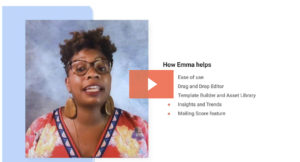Win the Inbox: Email marketing tactics you should retire yesterday
The team at Emma is here to help you send better emails, so we created a video series to equip you with all the knowledge you need to send messages your customers will want to open. In this video, Elizabeth Duffey discusses email tactics you should retire yesterday, as well as actionable alternatives you can employ today.
Email marketing is a must for any business, but it's undergone much-needed changes over the years. Yet, despite email marketing's evolution, there are outdated practices marketers continue to use, even now. (Your emails might even contain a few...)
Email marketing tactics you should retire right now
Tactic to retire #1: Bait-and-switch subject lines
First, the subject line is a bait-and-switch. It says, “We have a HUGE question for you,” but there’s not actually a question in the email.
Trust is key when building relationships with your email marketing. Clickbait subject lines definitely don’t facilitate that trust. Subscribers would much rather see a realistic hook about the email inside, so they can decide if they want to open it or not for themselves.
So, the key takeaway here: make sure your subject lines are authentic every time.
Tactic to retire #2: Batch-and-blast emails
The email says, “It’s sweater weather,” which makes sense to Nashvillians in the fall. However, for recipients that live somewhere else, like Florida, this headline might be irrelevant.
And sending the same email to your entire list is impersonal.
This is why segmenting for locations is so important, because you don’t want to blast subscribers with irrelevant messages.
Not to mention, segmented and targeted emails generate significantly more revenue compared to traditional mass blast emails.
Another key takeaway: segment your emails, so your content will be as relevant as possible.
Tactic to retire #3: The choice paradox
The CTAs (or calls to action) have a few issues. First, there’s a choice paradox. One says, “Visit the shop,” and the other says, “Download the class.”
Studies show if recipients have too many choices, they’ll feel overwhelmed.
And narrowing down to just one CTA will show the reader exactly where to click, which can actually increase sales. (Your boss will thank you.)
The key takeaway: give your users one actionable CTA, not several.
Tactic to retire #4: Friction words
Another thing about these CTAs? The friction words are a big red flag.
Yes, you want people to visit or download, but telling viewers what to do is something they don’t really like. It’s better to make the CTA an opportunity, not a command—and make converting sound beneficial. For example: “Discover the shop,” or “Start learning.”
The key takeaway here is: write CTAs that are opportunities, not commands.
Tactic to retire #5: Hyperlink CTAs
The CTAs also need to be buttons instead of hyperlinks. People don’t read emails like they read books. Emails are mostly being scanned, often on a phone or at work, so click-throughs need to be obvious and easy to click or tap.
We know using CTA buttons can increase click-through rates by 28% compared to traditional hyperlinks.
Our final takeaway: CTAs work better as buttons.
Wrap up
Be sure to check out Emma for even more email marketing resources. We have tons of helpful blogs, videos—and people—to help you elevate your emails and improve your marketing. So, what are you waiting for?
MOST RECENT ARTICLES
Want to engage your audience and grow your brand? Try Emma's robust easy-to-use product today.










